- Home
- Barry Unsworth
Land of Marvels Page 3
Land of Marvels Read online
Page 3
Now, to replace these invading hosts, there was the railway. With this thought, perhaps the cause of it, he became aware of shouting voices, a sudden clangor, as if sheets of metal were being thrown down. The sounds were familiar; they came from below, from beyond the eastern slope of the mound, ground invisible to him here, where he had never set foot, where the railway people had built their storage sheds and stacked the timbers for the line. Like a garden, Jehar had said. A railway line is built in patches, like a garden. He was clever with comparisons as liars often were. Not a liar exactly, he didn’t know the difference; truth, falsehood, it was all the same ground to him, he could step where he liked.
A series of muffled hammer strokes reached him, and the run of wheels on the light track the Germans had built for transporting the rails. Once again the question came to him, sickening in its quality of irresolution: Was he not a much worse liar, a real liar, one who told lies to himself? Deep within him did he not really want this railway track to come crashing through his mound, or close enough at least to put paid to any hope of further excavation? Convenient, a salve to his pride, if he could lay the blame for his failure on the incursion of the line. If the failure were seen to be his, it would reduce his chances—already not great—of finding a sponsor, raising money for other digs. His own money was running out; there would not be enough for another season . . .
The mound had seemed so promising. Higher than most, more than a hundred feet from ground level to summit, surmounted by a long ridge running east to west, the western end bumped up higher by a dozen feet, as if to indicate some more important edifice lying beneath, citadel or palace or the tower of a temple, stone perhaps, leaving a debris more substantial than the sun-dried mud brick generally used in this land of abundant alluvial deposit. Close to the base, exposed by the thousands of years of wind and water, they had come upon fragments of painted pottery of the late Ubaid period, which Somerville had thought might have been imported here, perhaps from as far away as Uruk, a great city in its day, whose ruins lay on the Tigris between Baghdad and Basra. This, if it were so, would argue a considerable degree of commercial importance as early as the sixth millennium before Christ.
But perhaps most important of all there had been the remembered advice of the man, much revered, whom Somerville had worked under as an assistant field archaeologist at Tell Harmal on the lower Tigris, his first work of excavation in Mesopotamia. If you want to make your mark, find somewhere to dig between the Belikh and the Khabur. Tell Erdek, say, or Tell Mahdin. Never been touched. You are on the borderlands of empire there. Find the right place and you will go down through half a dozen cultures, all the way to Neolithic.
Tell Erdek was the one he had chosen. It had the advantage of water not far away that could be drunk after filtering and boiling, and the village was close by, giving access to a labor force. They had leased the land from the local sheikh, had a house built, kept relations good by promising him the house—palatial by local standards—as a gift when the work there was finished.
They had proceeded in regular fashion, cutting the trench from the top of the mound to a point well beyond its foot; at exact intervals, in descending order, the work gangs were positioned, each with a measured square to work in. Quite soon, in their first season there, they had come to the remains of walls running across the line of the trench. But this had led to nothing much except an immense labor of clearance. So far only the ground plans of two small houses had come to light. They had found no substantial remains below the raised area on the west side; the rampart, so promising at first sight, had proved a purely accidental configuration. It was true that their pit had descended through empires: Layers of Parthian, Byzantine, Roman occupation had been found, then a thousand years or so of apparent nonhabitation, then Aramaean potsherds, then evidence of devastation by fire. Below the ash of this conflagration were the chipped flint ax heads of Neolithic man, a time before recorded history began.
The sequence was impeccable. But in all this time of digging nothing of major interest had been found, nothing that did more than reinforce what was known already. There was this piece of ivory, which had no context—so far at least—and therefore no meaning; in the previous season they had unearthed a stone-built Sumerian shrine with the small, badly damaged statue of a worshiper, further proof that the influence of Sumer had extended into this northern region, a fact amply demonstrated by others before him.
It was not much to show for all the work and all the money. He had pinned his hopes on Tell Erdek. It was the first time he had been in charge of an expedition, after the years as assistant at different sites in Anatolia and Mesopotamia. He had not come to archaeology in the usual way, through the usual stages, as Palmer had: distinguished university career, postgraduate studies in ancient history and Semitic languages, an assistant curatorship. After his years at Rugby he had joined the family firm and worked with his father, who had made a modest fortune in the Manchester cotton trade; there had not been much choice in this, he was the only child. He had not been happy, but he had gone on with it while his parents lived, spending what leisure time he had on studies begun in early boyhood relating to the history and archaeology of the Near East.
It had been his consuming passion. In an age of explorers and empire builders his hero had been an archaeologist, Henry Layard, whose excavations had revealed to the world the glories of ancient Assyria. In 1830, at the age of twenty-two, Layard had given up his position in a London law office and traveled on horseback through Anatolia and Syria. He had excavated Nimrud, with its colossal human-headed, five-legged bulls, uncovered the palace of Sennacherib at Nineveh and the many hundreds of cuneiform tablets from the archives of the Assyrian kings, an immense addition to human knowledge. And he was still not yet thirty! Somerville too, in conscious emulation, had given up everything for the sake of archaeology. His mother had died when he was still young. On his father’s death he had sold the business and the family home, invested the money, and offered himself as unpaid assistant to Sir William Forben, who was about to leave for Mesopotamia. He had always held to the similarity of circumstance between Layard and himself; their lives were connected by a bright and glittering thread; he too would become famous for his discoveries; he too would reveal to the world a splendor from underground, long unsuspected.
He was farther away from this now than ever. By the end of this third season, with the wages of two hundred workers to pay and the cost of transport to meet, he would be left with funds insufficient for another year. And now there was this sudden threat of the railway—for both sudden and insidious it had been. In 1912 and most of 1913, during the course of his first two seasons at Tell Erdek, the railway company had run into money problems; the line had been to all appearance abandoned. A branch line to Alexandretta had been completed and opened to traffic, but work on the Euphrates bridge had been suspended; the track had been halted just east of the river and might well have stuck there some years more. But in the previous December, while preparing to set out, he had learned from the Times that the Deutsche Bank had disposed of its holdings in the Macedonian Railways to an Austro-Hungarian syndicate and reinvested the funds thus obtained in the main line, confirming the company’s intention of taking it across Mesopotamia to Baghdad and Basra. He had had the proof of it this morning from the mouth of Jehar, who always looked at him so closely and intently, as if something more were expected, awaited, some inevitable end. Once again, with the same feeling of sickness, he was swept by the same question: Was it not he who was waiting for the end, for the line to come and pierce this bump of ancient ground and smash his hopes—hopes smashed already?
______
Jehar had watched the khwaja ascend to the summit of the mound and stand there looking toward the horizon, a motionless figure in his invariable dress of broad-brimmed hat and long-sleeved shirt and khaki shorts that came to his knees. It was important to keep the Englishman under observation as far as possible so as to know what progress was being m
ade in the search for the treasure. There was of course no possibility of knowing what was passing through the other’s mind as he stood there, and Jehar did not speculate: better the vacant mind than the mind occupied fruitlessly. But he would not have been in the least surprised to learn that he himself was featuring in the Englishman’s thoughts; he was convinced that their two lives were closely intertwined; it was this man who had singled him out, sent him to Aleppo first and then Jerablus to report on the progress of the railway; and it was in the railyards of Jerablus that he had seen the girl who had changed the whole course of his life, made him a different man.
She was called Ninanna, a beautiful name, unusual for a Circassian girl, and she was fifteen years old. This he had discovered from the man who called himself her uncle and perhaps was. They were Muhammadan people from the Caucasus Mountains who had fled south from the Russian Cossacks and taken refuge in parts of northern Syria. The uncle ran a bar with a few tables in the yards of Jerablus. Customers were not lacking; work on the bridge had been going on for two years, and in that time a township of hovels and shacks had sprung up to house the men who came to work on the construction or in the sawmills and coal sheds and to entertain them and skim off their wages: brothels and bars and gambling houses and pits for dogfights and makeshift stalls.
But it was not there, amid the fumes and clamor of the shunting yards, that he had seen her first. She had been getting water from the pump near the offices of the German engineers, laughing and talking with two older women, and their eyes had met while the laughter was still in her face. He had known at that moment that she was for him. He had watched her walk away, with the tall jar held in place on its pad with one raised arm. And he had felt the deep disturbance of love at the sway of her walk, her beauty and strength and stateliness. Her head was covered by a scarf worn well forward, by which Jehar knew she was a respectable girl and unmarried, a fact confirmed when he spoke to the uncle, who was asking a hundred gold pounds for her.
From that moment the course of his life had changed. It was not a life that had been marked up till then by any great virtue or distinction. He was a Bedouin of the Harb people, a tribe not very numerous, pastoral and nomadic in their way of life. He had quitted the tribal lands before reaching the age of twenty, driven by a restlessness that had taken him far afield. He had worked in the kitchens of a Damascus hotel, in the fish market below the Galata Bridge in Constantinople, as a boatman on the Euphrates, transporting bitumen downriver from Hit to Baghdad. Sometimes, when he had no work and no money, he had stolen articles left unguarded. And sometimes, in lonely places, he had attacked and robbed some passerby. Then, in Mosul, in a dispute over cards, he had stabbed a man and wounded him badly. The man did not die; but he did not walk upright again, and Jehar was sent to prison for a term of seven years. Halfway through this he was offered an amnesty on condition he joined one of the forced labor gangs that were working under armed guard on the Baghdad Railway, blasting a way through the difficult terrain of the Amanus Mountains in Anatolia. He spent six years working on the railway, first as a laborer, then, when his quickness of mind was noted, as a courier along the line. It was during these years that he had learned some German, his great asset as a news bearer in Somerville’s eyes.
Was I that man? he thought, with continuing wonder, watching the figure above him, which remained motionless among the toiling people. This care, this deliberate waiting, was new to him. Through all the vicissitudes of his life the needs of the moment had been all that counted with him, the one constant element. He had taken what work he could find, leaving on a whim, an impulse, an urge for new horizons. Like many who live from day to day, he had always had a passion for gambling; a week’s pay would go on the turn of a card. Now, at thirty-four, cunning and care had descended on him; he had become a person who postponed his pleasures, planned ahead.
He knew where he would take the girl when they were married. He would take her to Deir ez-Zor on the right bank of the Great River. He had seen this town when he worked on the rafts that carried pitch to ar-Raqqah and the upper reaches of the river. It had a green islet in midstream and a permanent bridge that led over to the other bank. Six white minarets rose above the flat roofs, and to the east of the houses there were gardens and sown fields, a mass of green . . .
He was saving money, putting coin to coin. His savings were in a goatskin bag, resting against his stomach, below the robe, below the cloth belt and the knife. But he was far away from the sum he needed, the hundred gold pounds the uncle was asking for her. And he was ridden by fears: Some other man would look at her and want her, someone richer than he; the uncle, whom he didn’t like and didn’t trust, would lose patience and seek to use the girl for the pleasure of his customers.
He saw the man above him turn, begin to descend. Their destinies were linked; he knew it. Through this man he would make money more quickly. There were treasures of great price in the bowels of this hill, and now the railway line was threatening to come before these could be found. Profit could be made out of this by a man who kept watch and bided his time—a man such as he.
3.
In late afternoon the foremen’s whistles sounded, and Somerville, accompanied by Palmer and by his secretary, Gregory, began the checking of the finds, moving from one gang to the next. Gregory had his own secretary in attendance, a proudly smiling boy named Yusuf, whose special duty it was to bear the pen and the large red account book. Bringing up the rear were two men, one with a wicker basket, the other with a number of small boxes, not regular jobs these, but assigned from day to day and much coveted—the standard rate was three piastres per man.
At his approach the groups stopped work and squatted in a line. He began always with the senior member, the pickman, first inquiring the name.
“Qasmagi?”
“Daud Muhammad.”
“What have you got?”
Daud Muhammad had the handle and lower part of a large terra-cotta pot with a crude design of crosses incised around the base, some very small pieces of copper beaten out flat, fragments of painted pottery, and the bone haft of a knife much chipped away.
The smaller things Somerville scrutinized briefly then cast aside, without regard for any hopes the pickman might have set on them. The bone implement went into one of the boxes; the pieces of pottery were placed in the basket. This done, he considered for some moments. It was general practice to pay baksheesh for objects found, in addition to the daily wage. It was an insurance against theft and encouraged the workpeople to keep their eyes open. And the possibility of some large reward appealed to the gambling instinct, strong in most Arabs. Baksheesh accounted for about 20 percent of the total wage bill. But it was always necessary to lend weight by a pause for consideration.
“Four piastres,” he said, in clear and distinct tones.
This was immediately repeated in a loud voice by the pickman, both as public acknowledgment and as an aid to memory. The pen and the account book were handed to Gregory; Yusuf crouched and presented his back so that the name and the amount could be entered. There were four Daud Muhammads working on the site, and some further name or distinguishing feature had to be added so as to avoid confusion. This one was Daud Muhammad the Pockmarked. At the end of the week Gregory would add up the amounts, a difficult and complicated feat of arithmetic, sometimes disputed by the men themselves if the total did not correspond to their memory of it.
Somerville repeated the procedure with the remaining members of the group before moving on. The basket people sometimes made small finds, beads, rings, seals—objects that had escaped the notice of the spademan when the baskets were being filled.
Moving from group to group, he worked his way up the side of the mound. There were more fragments of pottery, some lapis lazuli beads, an almost intact cylinder seal with a design of foliage on it. A better than usual day, nothing outstanding. The seal looked interesting, though it would need careful cleaning with a solution of alcohol before much could be known for
sure about it.
“Where was this found?” he asked the spademan who had found it. The man pointed some yards to his right, on the eastern side of the mound, where a short lateral trench had been dug. It was in this area that the piece of ivory had been found.
Another group was working at the limit of this trench, and Somerville approached them now.
“Qasmagi?”
“Hassan Muhammad Ibrahim.”
“What have you got?”
But Hassan Muhammad did not answer at once, giving instead a broad and triumphant smile. There was a cloth at his feet as he squatted there, and he glanced down at this now, still delaying.
“What is it?” Palmer said. “What have you got?”
With the air of a conjurer the pickman drew the cloth away and lifted out with both hands a piece of stone, the shape of a narrow rectangle, broken at the edges, about a foot in length.
Somerville took it from him and looked down at it. It weighed less than he had expected, being no more than a couple of inches in thickness. Impacted clay obscured much of the detail, but he was looking at a fragment, part of some larger design, carved in low relief. He made out a descending curve, broken off at a point where it was growing steeper. A slight lump or protuberance, also broken off short, rested on the upper part of the curve. At a slightly lower level there was what looked like part of a two-stranded ring.

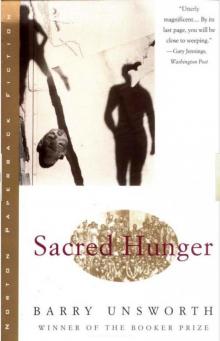 Sacred Hunger
Sacred Hunger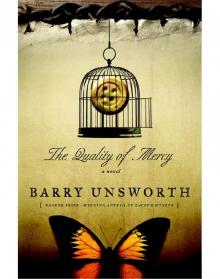 The Quality of Mercy: A Novel
The Quality of Mercy: A Novel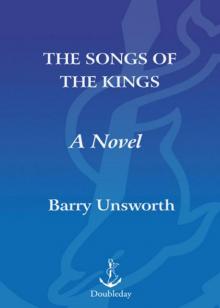 The Songs of the Kings: A Novel
The Songs of the Kings: A Novel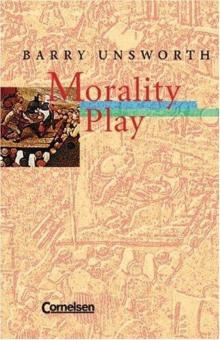 Morality Play. Mit Materialien. (Lernmaterialien)
Morality Play. Mit Materialien. (Lernmaterialien) Stone Virgin
Stone Virgin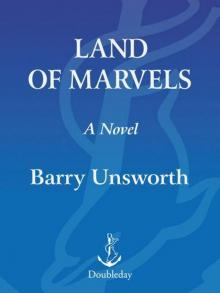 Land of Marvels
Land of Marvels Mooncranker's Gift
Mooncranker's Gift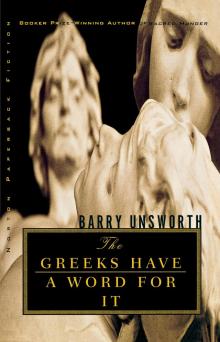 The Greeks Have a Word for It
The Greeks Have a Word for It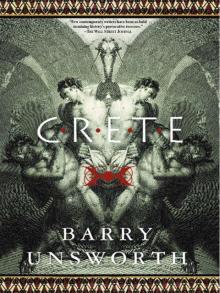 Crete
Crete The Partnership
The Partnership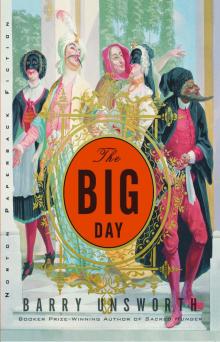 The Big Day
The Big Day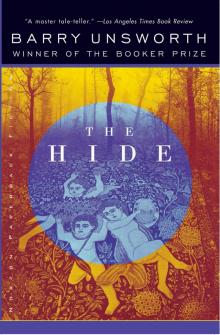 The Hide
The Hide Losing Nelson
Losing Nelson Morality Play
Morality Play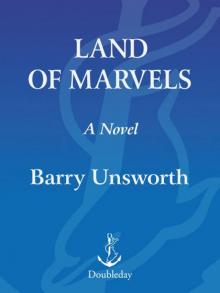 Land of Marvels: A Novel
Land of Marvels: A Novel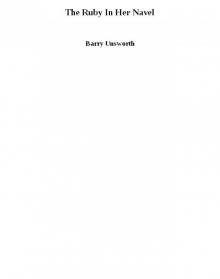 The Ruby In Her Navel
The Ruby In Her Navel